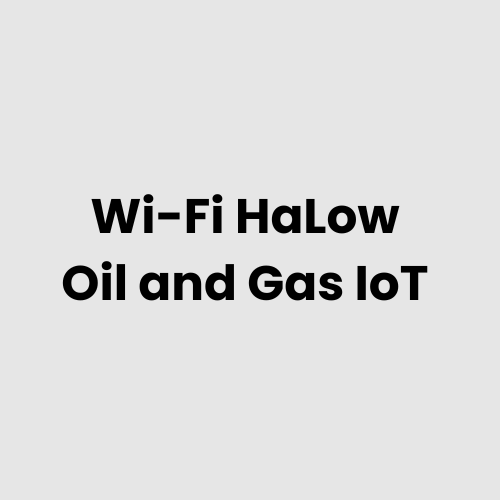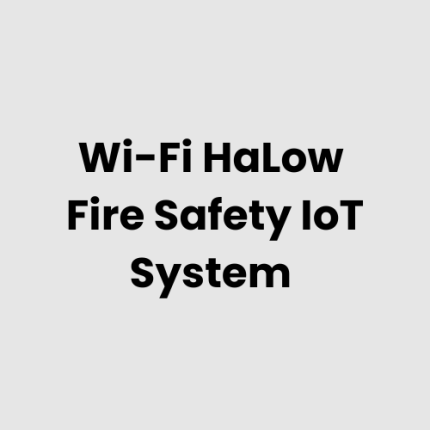Description
Technical Architecture of Wi-Fi HaLow Enabled Oil and Gas IoT System
The Wi-Fi HaLow Enabled Oil and Gas IoT System integrates advanced wireless communication technologies to support remote monitoring and automation in the oil and gas industry. The architecture is designed to enable real-time data collection, analytics, and remote management.
- IoT Sensors: Sensors placed throughout the oil and gas facilities (e.g., pressure, temperature, flow, and vibration sensors) continuously collect critical operational data.
- Wi-Fi HaLow Connectivity: The system leverages Wi-Fi HaLow (IEEE 802.11ah) to provide long-range, low-power, and reliable connectivity for IoT devices in remote and challenging environments.
- Edge Devices: Local edge devices aggregate sensor data and preprocess it to reduce latency and network traffic before sending it to central servers or cloud platforms.
- Local Server: A local server hosts real-time data processing and decision-making algorithms, offering a high level of control and security at the facility.
- Cloud Integration: The system integrates with cloud platforms for advanced analytics, storage, and long-term data management.
- Data Security: Robust encryption protocols ensure secure data transmission and prevent unauthorized access to sensitive operational data.
Hardware List for Wi-Fi HaLow Enabled Oil and Gas IoT System
- IoT Sensors: Temperature, pressure, flow, vibration, and gas detection sensors.
- Wi-Fi HaLow Access Points: High-performance Wi-Fi HaLow access points for communication across vast areas.
- Edge Gateways: Devices for local data aggregation, preprocessing, and transmission to the server or cloud.
- Local Server: For real-time data processing, management, and analytics.
- Power Supply Units: Redundant power systems to ensure continuous operation in harsh environments.
- Communication Antennas: Directional and omnidirectional antennas designed to support long-range communication.
- Mobile Devices: Tablets or handheld devices for operators to monitor and control systems remotely.
Physical Placement Considerations of Hardware
- IoT Sensors: Sensors should be strategically placed near critical equipment such as pumps, valves, and pipelines to continuously monitor operational parameters.
- Wi-Fi HaLow Access Points: Access points should be positioned to provide wide coverage across the facility, including remote or underground areas, ensuring reliable connectivity for IoT sensors.
- Edge Gateways: Located close to the sensor clusters, edge gateways should be installed in central areas to minimize data transmission latency and ensure quick decision-making.
- Local Server: The server should be housed in a secure, temperature-controlled room within the facility to ensure continuous, uninterrupted operation.
- Power Supply Units: Redundant power systems should be positioned to ensure minimal risk of failure, with backup systems in place to guarantee uptime.
Hardware Architecture of Wi-Fi HaLow Enabled Oil and Gas IoT System
The hardware architecture of the Wi-Fi HaLow Enabled Oil and Gas IoT System is optimized for high reliability and scalability in challenging environments:
- Sensor Layer: Comprises various industrial-grade sensors responsible for monitoring vital parameters like pressure, temperature, and flow rates.
- Communication Layer: Wi-Fi HaLow-enabled devices ensure robust connectivity over long distances while consuming low power, ideal for remote oil and gas sites.
- Edge Computing Layer: Edge gateways collect, filter, and analyze data locally before transmitting it to central systems, reducing bandwidth requirements and latency.
- Server Layer: Local servers process and store real-time operational data, enabling immediate decision-making and system response.
- Cloud Layer: Data from local systems is aggregated for long-term storage and advanced analytics, accessible through secure cloud platforms.
Deployment Considerations of Wi-Fi HaLow Enabled Oil and Gas IoT System
- Environmental Factors: The deployment must consider extreme weather, temperature fluctuations, and potential exposure to hazardous chemicals, ensuring that hardware components are rugged and certified for industrial use.
- Network Coverage: Ensuring that the Wi-Fi HaLow access points provide full coverage across the site, including underground and remote areas, is crucial for continuous operation.
- Scalability: The system should be designed for scalability to accommodate future expansion as new sensors and devices are added over time.
- Security: With the critical nature of oil and gas operations, data security is paramount. All devices and communication channels should be encrypted and secured to prevent unauthorized access.
- Maintenance: Regular maintenance and testing of IoT sensors and connectivity devices should be planned to ensure consistent operation and minimal downtime.
List of Relevant Industry Standards and Regulations
- ISO 9001:2015 (Quality Management Systems)
- IEC 61508 (Functional Safety)
- NIST SP 800-53 (Security and Privacy Controls for Federal Information Systems)
- ISO 14001:2015 (Environmental Management Systems)
- ATEX Directive (Hazardous Area Equipment)
- IECEx (International Certification for Explosive Atmosphere Equipment)
- ANSI/ISA-18.2 (Alarm Management)
- API 650 (Tank Design)
- API 653 (Tank Inspection, Repair, Alteration, and Reconstruction)
Local Server Version of Wi-Fi HaLow Enabled Oil and Gas IoT System
The Wi-Fi HaLow Enabled Oil and Gas IoT System can be deployed with a local server for enhanced data processing and operational control. The local server version allows for:
- Real-time Data Processing: Ensuring low-latency decision-making at the site.
- Offline Capability: The system continues to operate even when cloud connectivity is temporarily unavailable.
- Enhanced Security: By keeping sensitive data onsite, the local server adds an additional layer of security for mission-critical operations.
GAO Tek Inc. can provide customized local server configurations to suit the specific needs of each deployment, ensuring reliability and seamless integration with the overall system.
Cloud Integration and Data Management
The Wi-Fi HaLow Enabled Oil and Gas IoT System is designed for seamless cloud integration, allowing for centralized data storage, advanced analytics, and long-term data management. Key features include:
- Data Collection and Storage: The system collects sensor data and stores it in cloud databases for easy access and retrieval.
- Analytics: Cloud-based analytics platforms can process vast amounts of data to provide actionable insights, optimize operations, and predict potential equipment failures.
- Remote Monitoring and Control: Operators can access the system remotely, receive alerts, and make adjustments to operations from anywhere, improving efficiency and response time.
- Data Security: Cloud platforms adhere to stringent security standards, ensuring that all data is encrypted during transmission and storage to prevent unauthorized access.
GAO Tek Inc. ensures that cloud integration is customized to meet the specific needs of each customer, providing them with the tools to manage their oil and gas IoT systems efficiently.
GAO Case Studies of Oil and Gas IoT
USA Case Studies
- Houston, Texas: A prominent oilfield deployed GAO Tek’s IoT solutions for pipeline monitoring. The system enabled real-time data collection on flow rates and pressure anomalies, reducing downtime and operational risks in the field. Learn more about pipeline monitoring technologies.
- Midland, Texas: An exploration company implemented IoT-enabled asset tracking for drilling equipment. GAO Tek’s technology enhanced inventory accuracy and streamlined logistics management in remote locations. Explore advancements in oilfield IoT.
- Denver, Colorado: A natural gas facility integrated IoT solutions for environmental monitoring. Using GAO Tek’s sensors, they achieved enhanced compliance with EPA regulations.
- Anchorage, Alaska: A refinery adopted IoT-based temperature and pressure monitoring to optimize operations in sub-zero environments. GAO Tek’s system ensured uninterrupted workflows and safety. Discover best practices for refinery safety.
- Casper, Wyoming: An oil and gas services firm utilized IoT asset tracking to manage their fleet of specialized vehicles. GAO Tek’s technology reduced turnaround time and improved route optimization. Read about the impact of IoT on fleet management.
- Bakersfield, California: GAO Tek provided IoT-enabled tank monitoring for a storage facility. This system ensured accurate measurement of oil levels and prevented overflow incidents. Learn about tank monitoring solutions.
- Williston, North Dakota: An oilfield operation deployed IoT sensors for equipment condition monitoring. GAO Tek’s predictive analytics enhanced maintenance scheduling, reducing costly equipment failures. Learn more about condition monitoring.
- Oklahoma City, Oklahoma: A midstream operator implemented GAO Tek’s IoT technology for pipeline leak detection, significantly improving response times and minimizing environmental damage. Explore leak detection standards.
- Lafayette, Louisiana: IoT solutions from GAO Tek enabled a processing plant to monitor hazardous gases in real time, ensuring worker safety and regulatory compliance. Learn about hazardous gas monitoring.
- San Antonio, Texas: A major refinery integrated IoT sensors to track worker safety metrics. GAO Tek’s system provided comprehensive analytics for enhanced incident prevention. Discover resources on worker safety analytics.
- Pittsburgh, Pennsylvania: IoT-enabled pressure sensors were deployed in a pipeline system to optimize flow rates and ensure pipeline integrity. GAO Tek’s expertise streamlined the implementation process. Learn about pipeline integrity management.
- New Orleans, Louisiana: An offshore drilling operation adopted GAO Tek’s IoT technologies to monitor equipment usage and environmental parameters, increasing operational efficiency. Explore offshore monitoring technologies.
- Corpus Christi, Texas: GAO Tek’s IoT solutions were utilized for real-time monitoring of corrosion levels in pipelines, helping extend infrastructure life cycles. Learn about corrosion monitoring standards.
- Tulsa, Oklahoma: A storage facility relied on GAO Tek’s IoT systems for tracking hazardous materials and ensuring regulatory compliance in the energy sector. Read more about hazardous material tracking.
- Cheyenne, Wyoming: GAO Tek’s IoT technology helped a gas extraction company monitor emissions and comply with federal air quality standards, enhancing sustainability practices.
Canada Case Studies
- Calgary, Alberta: An oil sands operator implemented GAO Tek’s IoT solutions for equipment tracking and environmental monitoring, improving operational efficiency and regulatory compliance. Learn more about oil sands technology.
- Fort McMurray, Alberta: A remote oilfield leveraged GAO Tek’s IoT technologies for worker safety and asset monitoring. The system provided real-time insights, ensuring swift responses to potential risks. Explore worker safety protocols.
Navigation menu for Wi-Fi HaLow
- Wi-Fi HaLow Gateways/Routers
- Wi-Fi HaLow End Devices
- Wi-Fi Halow – Cloud, Server, PC & Mobile Systems
- Wi-Fi HaLow Accessories
Navigation Menu for IoT
- LORAWAN
- Wi-Fi HaLow
- Z-WAVE
- BLE & RFID
- NB-IOT
- CELLULAR IOT
- GPS IOT
- IOT SENSORS
- EDGE COMPUTING
- IOT SYSTEMS
Our products are in stock and can be shipped anywhere in the continental U.S. or Canada from our local warehouse. For any further information, please fill out this form or email us.
We are looking for partners. For more information on partnering with GAO, please visit Partner with GAO Tek Inc. It lists various ways to partner with GAO, such as OEM Partnerships, Technology Integration, Distribution and Reselling Opportunities, Presenting at the Leading Event TekSummit, Joint R&D Projects, Training and Consulting Services, Industry-Specific Collaborations, Research and Academic Partnerships.



